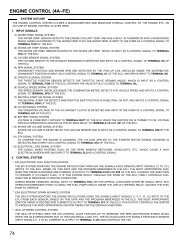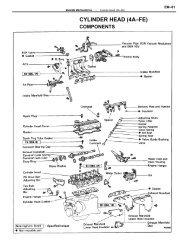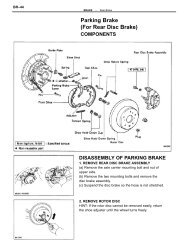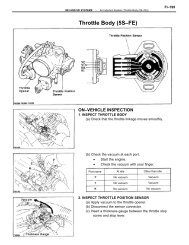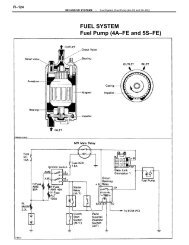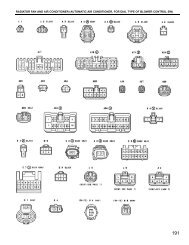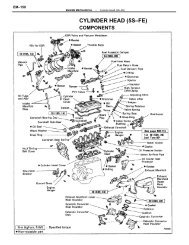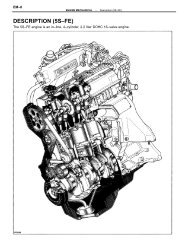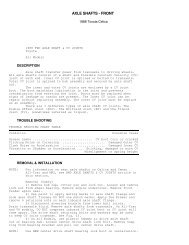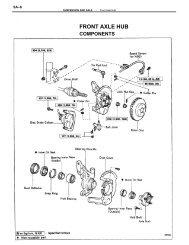a/c compressor oil checking - CelicaTech
a/c compressor oil checking - CelicaTech
a/c compressor oil checking - CelicaTech
Create successful ePaper yourself
Turn your PDF publications into a flip-book with our unique Google optimized e-Paper software.
A/C COMPRESSOR OIL CHECKING1988 Toyota Celica1988 A/C Compressor Refrigerant Oil CheckingCamry, Celica, Corolla, Cressida, Land Cruiser, MR2,Pickup/4Runner, Supra, Van/Wagon* PLEASE READ THIS FIRST *CAUTION: When discharging air conditioning system, use only approvedrefrigerant recovery/recycling equipment. Make every attemptto avoid discharging refrigerant into the atmosphere.ISOLATING COMPRESSORNOTE: Only <strong>compressor</strong>s with stem-type service valves can beisolated.1) Connect service gauge set to the <strong>compressor</strong> service valvesand open <strong>compressor</strong> valves slightly (turn in clockwise). Start engineand operate air conditioning. Slowly turn <strong>compressor</strong> suction valveclockwise toward closed (front-seated) position.2) When suction pressure is reduced to zero or less, turn offengine and <strong>compressor</strong> and quickly turn suction valve stem in to fullfront-seated position. Suction pressure should be slightly above zero.Turn discharge valve into front-seated position.3) To check <strong>oil</strong> level, slowly open <strong>compressor</strong> crankcase plugto relieve any remaining pressure. After <strong>oil</strong> level is corrected, capservice gauge ports on both valves. Back-seat suction service valve toallow refrigerant to enter <strong>compressor</strong>. Open discharge valve halfway.4) Loosen discharge service valve cap, allowing refrigerantpressure to force air out of <strong>compressor</strong>. Back-seat service valve andtighten cap. Compressor is now ready for operation.REFRIGERANT OILOnly new, pure, moisture-free refrigerant <strong>oil</strong> should be usedin the air conditioning system. This <strong>oil</strong> is highly refined anddehydrated to a point where moisture content is less than 10 parts permillion. The <strong>oil</strong> container must be tightly closed at all times whennot in use, or moisture will be absorbed into the refrigerant <strong>oil</strong> fromthe air.SERVICING PRECAUTIONSDISCHARGING SYSTEMCAUTION: When discharging air conditioning system, use only approvedrefrigerant recovery/recycling equipment. Make every attemptto avoid discharging refrigerant into the atmosphere.If <strong>compressor</strong> has stem-type service valves, it can beisolated and removed without discharging entire system. Otherwise,discharge system completely using approved refrigerantrecovery/recycling equipment before loosening any fittings.DISCONNECTING LINES & FITTINGSAfter system is discharged, carefully clean area around all
fittings to be opened. Always use 2 wrenches when tightening orloosening fittings to avoid twisting or distorting lines. Cap or plugall openings as soon as lines are removed. DO NOT remove caps untilimmediately before connections are made. This will keep entry of airand moisture to a minimum.CONNECTING LINES AND FITTINGSA new gasket or "O" ring should be used in all instances whenconnecting lines or fittings. Dip "O" ring in new refrigerant <strong>oil</strong> andensure it is not twisted during installation. Always use 2 wrenches toprevent damage to lines and fittings.PLACING SYSTEM IN OPERATIONAfter component service or replacement has been completed andall connections have been made, evacuate system throughly with avacuum pump. Charge system with proper amount of refrigerant andperform a leak test. See REFRIGERANT OIL & R-12 CAPACITIES table inthis article for system capacities. Be sure to check all fittings thathave been opened. After system has been leak tested, make a systemperformance check.NOTE:Air conditioning systems will not normally need addition ofrefrigerant <strong>oil</strong> unless definite <strong>oil</strong> loss has occurred due toruptured lines, leaking <strong>compressor</strong> seals, <strong>compressor</strong>overhaul or component replacement.NIPPONDENSO10-CYLINDERWhen inspecting system for <strong>oil</strong> loss, look for signs ofleaking (shiny, wet spots on components or underside of hood). If <strong>oil</strong>leak is noted or component replacement is required, use the followingprocedure as indicated:No Oil LeakDischarge system using approved refrigerant recovery/recycling equipment and change components as necessary. Addrefrigerant <strong>oil</strong> to components as necessary.Oil Leak1) Slowly discharge system using approved refrigerantrecovery/recycling equipment. Repair or replace faulty components. Ifequipped with a drain plug, remove plug, drain and discard <strong>oil</strong>. If notequipped with a drain plug, remove <strong>compressor</strong> from vehicle and pour<strong>oil</strong> out suction and discharge ports.2) Replace drain plug (if equipped). Add 1.5 ounces of newrefrigerant <strong>oil</strong> through suction port. Use new gaskets or "O" ringswhen replacing suction and discharge lines.Compressor Failure or System ContaminatedIf either situation exists, discharge system using approvedrefrigerant recovery/recycling equipment and remove <strong>compressor</strong>,receiver-drier and expansion valve. Clean expansion valve screen.Flush entire system. Install new <strong>compressor</strong> and receiver-drier. New<strong>compressor</strong>s contain correct amount of <strong>oil</strong>. If installing overhauled<strong>compressor</strong>, add 1.5 ounces of new refrigerant <strong>oil</strong> through suctionport.REFRIGERANT OIL & R-12 CAPACITIES TABLE
¡ ¡ ¡ ¡ ¡ ¡ ¡ ¡ ¡ ¡ ¡ ¡ ¡ ¡ ¡ ¡ ¡ ¡ ¡ ¡ ¡ ¡ ¡ ¡ ¡ ¡ ¡ ¡ ¡ ¡ ¡ ¡ ¡ ¡ ¡ ¡ ¡ ¡ ¡ ¡ ¡ ¡ ¡ ¡ ¡ ¡ ¡ ¡ ¡ ¡ ¡ ¡ ¡ ¡ ¡ ¡ ¡ ¡ ¡¡ ¡ ¡ ¡ ¡ ¡ ¡ ¡ ¡ ¡ ¡ ¡ ¡ ¡ ¡ ¡ ¡ ¡ ¡ ¡ ¡ ¡ ¡ ¡ ¡ ¡ ¡ ¡ ¡ ¡ ¡ ¡ ¡ ¡ ¡ ¡ ¡ ¡ ¡ ¡ ¡ ¡ ¡ ¡ ¡ ¡ ¡ ¡ ¡ ¡ ¡ ¡ ¡ ¡ ¡ ¡ ¡ ¡ ¡Application (1) Oil Ounces R-12 OuncesLand Cruiser .............. 3.4 .................. 23-27VanSingle Unit .......... 2.0-3.4 ................. 21-27Dual Unit ............ 2.0-3.4 ................. 48-51All Other Models ....... 2.0-3.4 ................. 21-27(1) - Total system capacity, unless otherwise noted.



